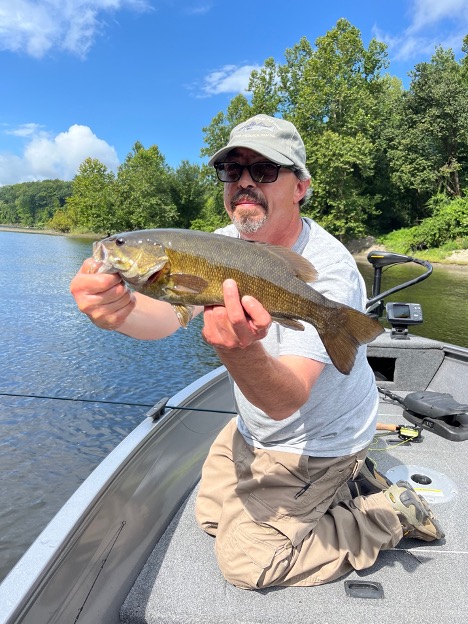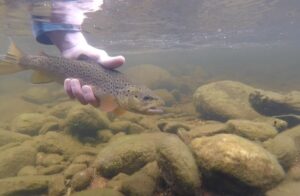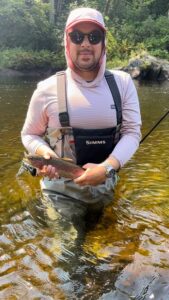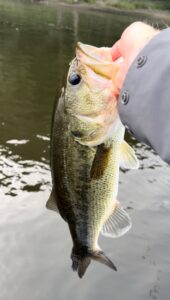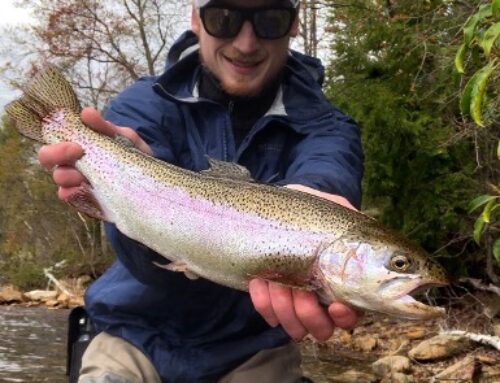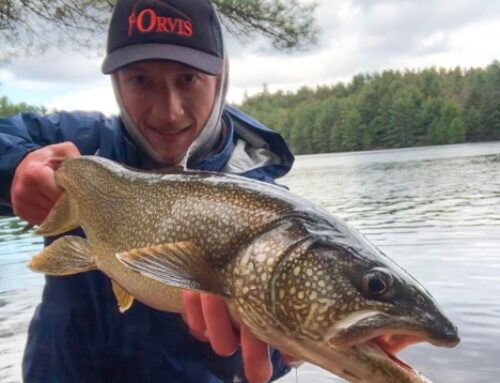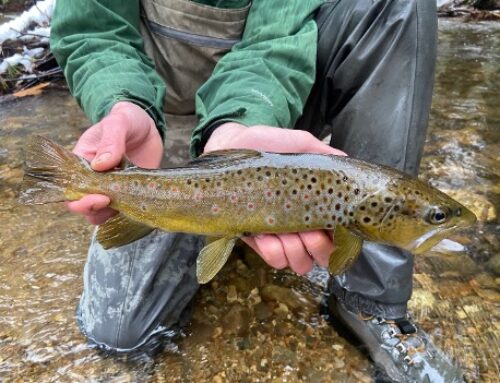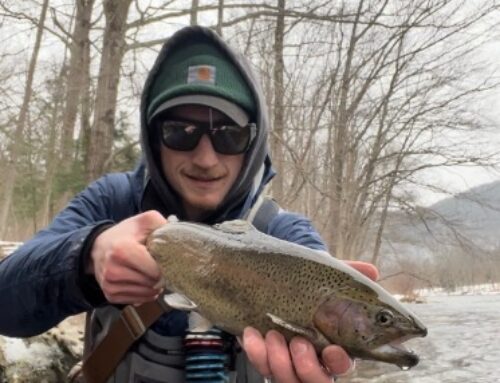All of a sudden, the days are cooling, the nights are even cooler, and the end of summer is in sight. This time of year is marked by significant fluctuation across the fishery and yields some excellent opportunities to target a myriad of different options.
On the Deerfield, flows have leveled back out after a high-water period earlier on in August. The high water compounded by chilly overnights have done a lot to cool the river down, and while it’s still important to be mindful of temps—especially early in the week when the river is running low for extended periods of time—we’re likely only a week or two away from regularly decreasing water temperatures.
Whether fishing the D on low (usually 125 CFS) or high (usually 800 CFS) flows, one of the top tickets continues to be high floating terrestrial patterns. Terrestrial fly selection isn’t terribly important, but you can never go wrong with a chubby Chernobyl or PMX. When fishing such patterns in low water, it’s a good idea to focus attention on turbulent pockets where fish have limited ability and time to analyze your presentation, often striking quickly and aggressively after the fly lands. In higher flows, it’s a good approach to focus on margin water where many fish move when the water comes up. In either case, do what you can to deliver terrestrial flies with authority as a sharp splat when landing calls fish in like a dinner bell. A single haul on the forward cast is a good way to generate the line speed necessary to execute a cacophonous landing of the fly.
When fishing with large terrestrials, it’s often a good idea to run a hopper dropper with either a nymph or smaller dry fly behind the terrestrial; a rig which can help convert fish that might be drawn in by the big bug but are reluctant to take it. When dropping nymphs, consider tying on jigged patterns which usually have a faster fall rate than flies tied on traditional hooks, a huge advantage in tight pockets and troughs where it’s important to get flies down as quickly as possible. From the tying perspective, overweighting jigged nymphs with a sized-up tungsten bead can help increase fall rate.
Aside from the big terrestrials, the Deerfield has been seeing significant numbers of fish feeding on ants. Non-flying ants are of course closely associated to bank vegetation so it’s a good idea to focus attention on tree overhangs and brushy areas. Flying ants will be more widely distributed as they are weak navigators in the air and tend to get blown into the water by even the slightest wind. In any case, these small bugs are well imitated with flying ant and para-ant patterns in sizes #16-20. Size and profile will be more important than color, but you can’t go wrong with presentations in both black and cinnamon.
As for more traditional hatches, things continue to be pretty sparse. There are modest numbers of isonychia mayflies (“isos,” #12-14) coming off which are joined by some blue winged olives (#18-22) and cream cahills (#14-16), all of which have generally been showing up intermittently throughout the day. Because these hatches have been spotty, it’s a good idea to remain pretty all-purpose with mayfly imitation rather than home in on something too specific. Para-Adams, usuals, klinkhammers, sparkle duns and the like are always solid options when there are some mayflies around. In addition to mayflies, there are also some tan caddis still around, usually in sizes #16-20; elk hair variants, CDC caddis variants and the like will all play well. The big-ticket hatch to keep eyes out for is the arrival of the October caddis. These relatively giant caddisflies should start cropping up in the next few weeks and can be an absolute blast when fish get on them. For imitation, you can’t go wrong with a Goddard caddis on the surface, but keep in mind that a lot of fish feeding on Octobers are feeding subsurface on pupating larva. Both swinging and dead-drifting soft hackles and other pupa imitations can be deadly, and remember that these are big bugs, often as large as a size #8 and rarely smaller than #12.
While thinking about upcoming fall patterns on the Deerfield, the conversation would not be complete without some discussion of streamer fishing. In the early fall, many fish begin looking more and more at large forage options as they prepare for the modest pickings of winter. This fact is doubly true for the Deerfield’s wild brown trout who not only need to prepare for the coldest months but are also looking to pack on as much poundage as possible in preparation for their spawning season. The spawn itself is still weeks out, usually occurring between late October and into December, but pre-spawn activity is certainly closer than it may seem. Streamer fishing on the Deerfield is usually at its best on higher flows, but opportunities can also be had in low water, specifically where water is turbulent. In either case, it’s usually most productive to fish streamers on sinking heads but floating lines can work if need be. If you’re just getting into sinking lines and not yet ready to make the investment, a detachable sinking leader like Rio’s VersiLeader is a great option (which we carry in the shop). As for streamer selection, make sure to stop by the shop to check out our wide array of meat patterns; we just got a whole lot of great options in.
Elsewhere, the Millers and Westfield Rivers have also returned to lower flows after the high-water event in August. Fortunately, all that water did a lot to cool both these fisheries down into ideal temperature ranges. Conditions are still fluctuating especially with the lack of rain we’ve had, so make sure to continue being aware of water temperatures; however, there should be ample opportunity for trout on both fisheries. Beyond that, much of what’s been said about the Deerfield will also be true on the Millers and Westfield with hopper/dry droppers performing well—especially for prospecting—and all-purpose dry flies doing solid business when hatches and/or rising fish are present. Looking ahead, keep in mind that both rivers will receive fresh stockings at the end of the month/beginning of October. Freshly stocked fish tend to be more than willing to hit just about anything that moves for their first week or so in the river so it’s a bit of dealer’s choice on presentation. As they become more educated and learn to feed naturally, you’ll likely need to adjust to their preference, however, most stocked fish (and many wild ones too) will happily take something junky like an egg or worm seven days a week.
On the Swift River, what wound up being a significantly long sulphur season has finally waned. This being said, there’s still plenty of fish rising to small terrestrials, the occasional blue winged olive & cream cahill, and of course midges. When targeting risers in the river’s margins, small ants, beetles and the like will fare well especially when cast in close proximity to bank vegetation where a lot of such bugs source from. Risers in the center of the river will usually be feeding on midges. However, you don’t necessarily need to be throwing the all-but-microscopic midge patterns common on the river. Small but at least visible CDC and poly-wing emergers in sizes #20-24 will get the job done in many situations. When the going gets tough on midge eaters, consider dropping a small, weightless nymph like a black beauty or tiny pheasant tail off of a small dry fly. The nymph will sit just below the surface and appear to be trapped in the surface film, a presentation that’s often good enough to deke finicky midge risers.
The big-ticket item on the Swift is the fast-approaching brook trout spawn. If you’ve not witnessed it, the river’s brookie spawn is nothing short of an aquarium-like experience as dozens upon hundreds of the most brilliantly colored fish imaginable perform their ancient mating rituals. Even without a rod in hand it is truly a must-see event. Increased brookie numbers have been observed in the fly-only section above Rt. 9 where a lot of the river’s brook trout head for the spawning season. No redds (i.e. nests) to speak of yet but we’re likely only a couple weeks out from the first fish digging into gravel. A cursory annual reminder to be very careful when fishing during this, and any, trout spawn. Be mindful of where you’re wading to avoid stepping on redds and never cast to spawning fish. We are extraordinarily lucky to have fisheries that boast such prolific wild reproduction and it’s essential to play by the rules during the mating season. This being said, some serious opportunities can be had during the spawn as many big rainbows and browns file in behind chains of redds to gorge themselves on egg forage. Eggs are a winning pattern on the Swift 365 days a year but fishing them to redd-raiding browns and bows can often yield lights out results. Is it really a junk pattern if that’s what they’re eating?
Looking at the area’s creeks and small streams, a significant lack of rain over the last several weeks has left flows on many pieces of small water very low. The good news is that this unseasonably cool weather has done a lot to keep most creeks cold enough to fish safely. When flows bottom out as they have, a lot of creek trout will make moves towards their system’s most stable depth so it’s a good idea to focus more attention on pools and plunges rather than riffles and runs. On a separate note, many small streams are also gearing up for the spawning seasons of their resident wild trout. Brookies tend to spawn earlier than browns, usually late September and well into October for the former and late October into November for the latter. From the conservation perspective, same rules as the Swift: watch where you’re wading and never cast to fish on redds. From the fishing angle, know that the creek dry fly bite usually dries up with the beginning of the spawn as fish begin winter preparations afterwards, so get in while the getting’s still good.
Outside the world of trout, fishing has been good. The Connecticut River has finally come back down into optimal flows after an extremely high-water period in August. Late summer/early fall smallmouth fishing on the big river can be excellent with a lot of big fish starting to put the feed bag on in preparation for colder days. The river is loaded with small shad and the smallies have taken note. The Connecticut can be a bit tricky to piece apart on foot, however, a concrete rule of thumb is to seek out stable rock structure—both on the bank and subsurface—where a lion’s share of smallies will relate to in any given area. If you’ve got a kayak or outboard craft, all the better.
Across the local warm water fishery, we’re entering a significant period of fluctuation. Bass both small and largemouth, northern pike, and chain pickerel will be on the move in search of high calorie opportunities. The concept of patterning becomes very important around this time of year as things that were true yesterday may be completely false today. You might find warm water sport fish in both moving and still water crashing the banks to entrap prey, or you might find them suspended over depth looking to sprint down a meal. Then again, you might find them relating closely to stable structure, lying in wait to mount an ambush. All this being said, keep an open mind while plying local warm water and do your best to build off both success and failure. While they might take some finding and patterning, hell hath no fury like a predator aiming to eat its way towards winter survival.
Off the water, we’ve got some new things to report as well as some exciting stuff on the horizon. We’ve just recently launched a blog space on our website with the first entry covering the essentials to finding success on local creeks and small water. If you’ve got an idea for a blog submission, shoot us an email or DM with a brief description of the topic you’re interested in covering; we’d love to hear from you!
As for events, we’ll be hosting a free clinic called Trout Spey Day where we’ll piece apart the basics of spey fishing. The clinic will take place from 9AM-noon on September 29th at our new satellite location at Zoar Outdoors on the banks of the upper Deerfield River in Charlemont. Jim Dowd, a Fly Fishing International certified fly casting instructor, will lead several demonstrations as well as hands on casting mini clinics throughout the morning. Some casting may take place on dry land but we will also, if conditions permit, take to the water to get a true sense of the Spey cast. Bring wading gear if you’d like to try your hand at it.
There are still spots left in our inaugural trip to Cuba. We have secured a great week at the end of February to target tarpon, permit and bonefish. Based out of a liveaboard cruise ship, we will take to smaller skiffs each day in search of the elusive grand slam in one of the most pristine and unspoiled flats fisheries on this planet. Check our website or email brian@deerfieldflyshop.com for more info.
As always, thank you for your continued support from all of us at the Deerfield Fly Shop. We hope to see you in the shop soon and wish you luck next time you’re on the water.

